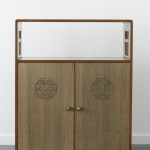



artisan's name unknown
Japanese Art Deco tansu, 1910s-1920s
Two Types of Wood with Silver Ornaments
26" X 20" X 12 1/2"
Sold
Further images
An artisan who made wooden furniture without using metal nails or metal joint is called Sashimono-shi. A master Sashimono-shi made the Tansu. A viewer would notice the air of Art...
An artisan who made wooden furniture without using metal nails or metal joint is called Sashimono-shi. A master Sashimono-shi made the Tansu. A viewer would notice the air of Art Deco style, and it is an interpretation of the style. Around the time, French and Japanese designers were influencing each other. However, it is rare to see the one influenced in Kyoto. Most of the Japanese designs with Art Deco aspect was made in Tokyo. This Tansu shows its origin, Kyoto eloquently. The color of the lacquer (subtle orange/brown of Shunkei lacquer ) of its frame, the size, the silver ornament on the door, its proportion and the balance are quintessentially Kyoto. It is a sophisticated fusion of east and west, without crashing to nor insisting on each other's statement. It is embracing each design elegantly.
Signup for our Newsletter
You will receive two emails a month from us. One introduces artworks and design works from Kyoto's hidden sources and the other is stories from Misako, sharing insights into Japanese culture.
* denotes required fields
为了回应您的查询,我们将根据我们的隐私政策处理您提供的个人数据。



